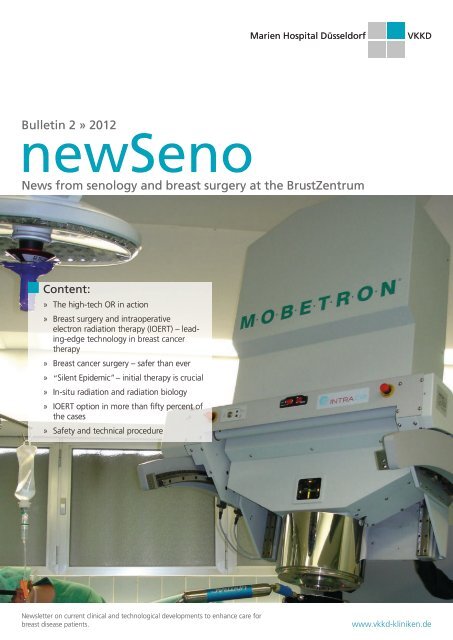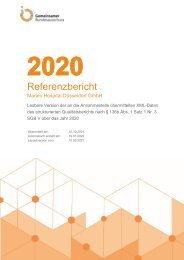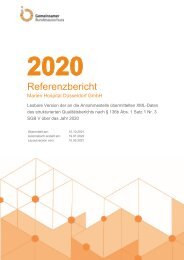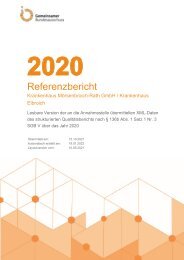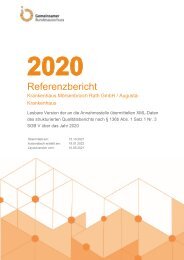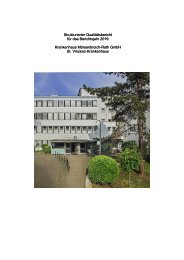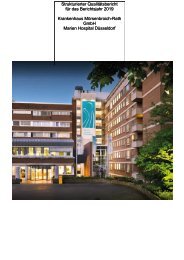newSeno Telegramm 2 | 2012
You also want an ePaper? Increase the reach of your titles
YUMPU automatically turns print PDFs into web optimized ePapers that Google loves.
Bulletin 2 » <strong>2012</strong><br />
<strong>newSeno</strong><br />
News from senology and breast surgery at the BrustZentrum<br />
Content:<br />
» The high-tech OR in action<br />
» Breast surgery and intraoperative<br />
electron radiation therapy (IOERT) – leading-edge<br />
technology in breast cancer<br />
therapy<br />
» Breast cancer surgery – safer than ever<br />
» “Silent Epidemic“ – initial therapy is crucial<br />
» In-situ radiation and radiation biology<br />
» IOERT option in more than fifty percent of<br />
the cases<br />
» Safety and technical procedure<br />
Newsletter on current clinical and technological developments to enhance care for<br />
breast disease patients.<br />
www.vkkd-kliniken.de
<strong>newSeno</strong> 2 » <strong>2012</strong><br />
• The high-tech OR in action<br />
Leading development<br />
After successful implementation and set-up, one of the<br />
ultramodern linear accelerators for intraoperative electron<br />
radiation therapy (IOERT) is now operating successfully at the<br />
Department of Senology and Breast Surgery at Marien Hospital<br />
Düsseldorf, Germany. The MOBETRON features radiation<br />
therapy and technology that ensures highest precision and<br />
stability. Furthermore, the MOBETRON’s penetration of the<br />
targeted tissue is superior to all currently available systems.<br />
Designed to provide highly differentiated, patient-centred<br />
and safe use it is one of the few high-performance devices<br />
of this generation internationally.<br />
A patient is prepared for radiation therapy during breast cancer surgery<br />
With its wide range of applications the MOBETRON outclasses<br />
some of the competitive devices that many renowned<br />
international radiation oncologists have called mere “flashlights”<br />
in comparison. We are very grateful that the generous<br />
substantial and mental support of our friends and<br />
supporters as well as the Marien Hospital Foundation enabled<br />
us to now offer our patients the best therapy worldwide.<br />
Do stem cells play a role?<br />
While surgery remains the crucial element of cancer management<br />
and particular in breast malignancies, today it is the<br />
combination of radiation therapy and surgery that are the<br />
basic most important principles for the longterm success<br />
of local cancer control and cure, and indeed it might play<br />
a more important role in the outcome than chemotherapy.<br />
This assumption is backed by data from our trial that we<br />
initiated twenty years ago in cooperation with the Department<br />
of Radiation Therapy of the University Hospital Düsseldorf.<br />
Fifteen years after the initial study the outcomes of more<br />
than 400 patients were reviewed – patients who had<br />
undergone radiation prior to surgery rather than after the<br />
surgery, which is the common procedure. Survival rates were<br />
significantly higher and cure rates are higher compared to<br />
pre-operative chemotherapy alone (see: Longterm outcome<br />
after neoadjuvant radiochemotherapy in locally advanced<br />
non-inflammatory breast cancer and predictive factors for<br />
a pathologic complete remission; results of a multi-variate<br />
analysis. San Antonio Breast Cancer Symposium <strong>2012</strong>.<br />
Presenting and Correspondence Author: Christiane Matuschek,<br />
<strong>2012</strong> CTRC-AACR, Abstract Number: 850076).<br />
Scientists assume that effective and targeted radiation therapy<br />
not only kills mature tumor cells (as in case of chemotherapy)<br />
but possibly also stem cells and precursor cells<br />
which are known to be highly resistant. The major role of<br />
these “dangerous loners“, also with regard to metastases, is<br />
brilliantly described in Bördlein‘s article in the May issue of<br />
the Deutsches Ärzteblatt (I. Bördlein, Deutsches Ärzteblatt,<br />
Jg: 109,19/11.03.<strong>2012</strong>).<br />
Breast cancer surgery – safer than ever<br />
With regard to a sustainable positive long-term effect of the<br />
intraoperative radiation therapy the MOBETRON allows also<br />
for an electron boost prior to resection. In selected or more<br />
advanced cases after chemotherapy the accelerator enables,<br />
because of its advanced target volume, an electron beam for<br />
a few minutes prior to the removal of the tumor during the<br />
surgical intervention. In terms of radiation biology the effect<br />
of this approach is identical to radiation therapy weeks before<br />
surgery. The advantage however is twofold: the volume<br />
of the tumor bed containing the stem cells is radiated in a<br />
highly targeted way with normal vascularisation and oxygenation.<br />
Furthermore the radiation exposure of healthy breast<br />
tissue and adjacent organs (heart and lungs) is avoided. We<br />
consider this procedure, which is called intraoperative insitu<br />
radiation, with the latest generation MOBETRON to be<br />
an important option in addition to standard post-resection<br />
IOERT after the removal of the tumor within clear margins.<br />
Research provides detailed information and evidence on the<br />
post-surgery development of distant metastases (Vicini, F., A.<br />
et al.: Hazard ratios for the development of Distant metastasis.<br />
Cancer 97:910-19, 2003) that support our confidence in<br />
this clinical approach. During our in-situ radiation, a procedure<br />
which is also applied optionally in the US, we deliver<br />
highly targeted so-called boost radiation to the tumor and<br />
thus also to the tumor stem cells, which may be mobilized<br />
and activated by the intervention.<br />
Breast cancer – a silent epidemic: initial therapy is crucial<br />
Breast cancer is one of the most frequent and most heterogeneous<br />
malignant diseases. Moreover tumor biology and<br />
anatomy (size and location) are highly varied. Thus successful<br />
treatment requires meticulous planning and above all an<br />
initial therapy that is tailored to each individual patient.<br />
2
25 years ago we developed<br />
the oncoplastic procedures<br />
that combines safe tumor<br />
resection and reconstruction<br />
with an excellent oncological<br />
and esthetic outcome<br />
and the avoidance of any<br />
call back for re-excision<br />
or corrective sequential<br />
interventions in breastconserving<br />
surgery.<br />
Intraoperative electron radiation therapy (IOERT) delivered<br />
by the state-of-the art MOBETRON is a further significant<br />
component in our efforts to make safe breast conserving<br />
available for our breast cancer patients.<br />
• The procedure<br />
Indication and resection margins<br />
IOERT as anticipated boost radiation is indicated for a wide<br />
variety of cases and can be applied in more than fifty percent<br />
of all breast cancer patients. Outcomes depend to a large<br />
degree on the initial precise surgical procedure. Multicentricity<br />
is excluded in diagnostic MR mammography and tumor<br />
location is determined sonographically prior to the targeted<br />
radiation. A pathologist is present during the surgery to<br />
perform important histological evaluations.<br />
The four-eye principle increases targeting precision<br />
Soft-docking of the electron<br />
accelerator prior to radiation<br />
without direct contact to the<br />
field of intervention<br />
IOERT should only be offered to patients who most likely<br />
will not require adjuvant chemotherapy, in order not to delay<br />
post-IOERT adjuvant radiation therapy due to an extended<br />
chemotherapy period. If primary chemotherapy is indicated,<br />
a neoadjuvant chemotherapy protocol is initially applied.<br />
If unexpectedly post-IOERT chemotherapy is indicated, the<br />
tumor board will decide on a case-by-case basis. Ideally,<br />
a combined radiation/chemotherapy regime is applied,<br />
followed by standard adjuvant chemotherapy.<br />
Special case: intramammary relapse<br />
Previously radiated patients with an intramammary relapse<br />
require a special approach. Secondary breast-conserving<br />
intraoperative radiation therapy can be performed, however<br />
only on the basis of an informed consent and after comprehensive<br />
information. In these cases no percutaneous radiation<br />
therapy will follow since this would exceed dose<br />
guidedelines. All indications are discussed by the radiooncology<br />
board.<br />
Safe margins/radiation field<br />
With small tumors (up to 2 cm diameter) the radiation field<br />
will be 1 to 2 cm larger than the resection field. With larger<br />
tumors (more than 2 cm diameter) the radiation field is 2 to<br />
3 cm larger than the resection field.<br />
Protocol: Intraoperative boost radiation of a breast<br />
carcinoma using MOBETRON<br />
This protocol contains the key parameters such as field of<br />
radiation in the left/right breast; quadrants, type of IOERT<br />
(pre-/post-tumor resection), with/without skin island,<br />
intraoperative histological<br />
evaluation: tumor size/<br />
resection borders, tissue<br />
thickness, distance to<br />
the thorax wall, energy<br />
(6MeV/9MeV/12MeV),<br />
tube diameter/angle, bolus,<br />
dose: (in dmax) Gy, monitor<br />
settings: MU, radiation<br />
therapist, medical physicist,<br />
surgeon with sign-off by<br />
radiation therapist and medical<br />
physicist.<br />
Application<br />
In our high-tech OR equipped<br />
with a special OR table for<br />
Stable anchorage of the tube with<br />
Unitrac-System<br />
IOERT the radiation takes only a few minutes. We use Unitrac,<br />
a surgical restraint system that allows single-handed and very<br />
fast positioning of the tube in the correct angle. The skin is<br />
distanced with two holding sutures and the electron beam is<br />
set under laser guidance with the MOBETRON‘s soft docking<br />
feature. Actually the IOERT takes three to five minutes while<br />
the patient is being monitored with a camera system. The<br />
intervention is concluded with oncoplastic and reconstructive<br />
proce-dures. No permanent wound cavity will remain.<br />
3
<strong>newSeno</strong> 2 » <strong>2012</strong><br />
• Summery<br />
IOERT post-tumor resection with safe margins<br />
• Targeted radiation by the surgeon<br />
• Healthy breast tissue and adjoining organs are spared<br />
• Shorter radiation times<br />
IOERT prior to tumor resection – in-situ radiation<br />
Advantages:<br />
• Undisturbed vascularisation and oxygenation of the tumor<br />
and the directly surrounding tumor bed<br />
• Possible effects on the stem cells (see neoadjuvant radiation<br />
therapy study)<br />
• More precise positioning of the tube with regard to medial,<br />
cranial, caudal, lateral and particularly deep margins<br />
Indication and eligibility:<br />
• Tumor anatomy (unifocal, delineated, smooth surface)<br />
• Favourable relative tumor size or index tumor size post<br />
chemotherapy<br />
• Tissue transfer intended<br />
• Case-by-case decisions: LABC, relapse or sarcoma<br />
The decisive aspect in favour of the Marien Hospital Düsseldorf<br />
and the VKKD of the new MOBETRON and the high-tech<br />
OR environment is a major step towards becoming a leading<br />
national and international provider of comprehensive services<br />
in oncology.<br />
New standard text book<br />
Advanced Therapy of Breast Diseases (ISBN: 978 - 1- 60795 -<br />
094 - 3), editor: MD Anderson Cancer Center in Houston,<br />
University of Texas (USA). The MD<br />
Anderson Cancer Center, a worldwide<br />
leading healthcare institution, invited<br />
me as the first European physician to<br />
contribute a chapter on developments in<br />
oncoplastic surgery (chapter 40). This is<br />
a great honour and bears witness to the<br />
fact that today our breast surgery department<br />
and the oncoplastic interventions<br />
we have developed are recognized as the<br />
international standard. This comprehensive<br />
publication covers all diseases of the female and male<br />
breast. In short: an excellent reference work for all who are<br />
interested in the current international developments in breast<br />
disease research and therapy.<br />
Marien Hospital Düsseldorf<br />
Klinik für Senologie und Brustchirurgie<br />
Rochusstraße 2<br />
40479 Düsseldorf<br />
www.vkkd-kliniken.de<br />
More information and download of <strong>newSeno</strong> and direct<br />
patient referral form: www.brustzentrum-duesseldorf.de<br />
Responsible for this publication:<br />
Director, Department of Senology and Breast Surgery, a.r. Prof. Dr. med. Werner Audretsch<br />
Managing directors, Marien Hospital Düsseldorf, Dr. Martin Meyer, Jürgen Braun<br />
Klinik für Senologie und Brustchirurgie<br />
BrustZentrum am Marien Hospital Düsseldorf<br />
24 h service:<br />
Daytime: +49 (0) 2 11 44 00 - 27 61, mobile: +49 (0) 1 72 2 57 22 96<br />
Fax: +49 (0) 2 11 44 00 - 27 62<br />
brustzentrum@vkkd-kliniken.de<br />
Our distinctive competencies<br />
• Breast surgery and -service for female and male patients<br />
without restrictions<br />
• High-resolution breast ultrasound, US-guided biopsy and<br />
wire localisation<br />
• Sentinel lymph node biopsy and node sparing surgery<br />
• Breast conserving surgery and oncoplastic breast surgery<br />
• Intraoperative radiation therapy IOERT and brachytherapy<br />
• Skin-sparing (SSM) and nipple sparing mastectomy (NSM)<br />
with immediate reconstruction<br />
• All types of reconstruction techniques with highest degree<br />
of safety<br />
• Reconstruction with silicone prostheses/expander or with<br />
own tissue (abdomen or back)<br />
• Secondary and tertiary interventions with highest quality<br />
• Relapse surgery with and without breast tissue sparing<br />
procedures<br />
• Individual correction of malformations, breast reduction<br />
and breast augmentation, gynaecomastia in men, all<br />
techniques of aesthetic breast surgery<br />
a.r. Prof. Dr. med. Werner Audretsch<br />
Director<br />
Telephone +49 (0) 2 11 44 00 - 27 61<br />
Mobile/Text +49 (0) 1 73 7 14 54 80<br />
werner.audretsch@vkkd-kliniken.de<br />
Dr. med. Oksana Möller<br />
Managing consultant<br />
Telephone +49 (0) 2 11 44 00 - 64 53<br />
Office/Mobile/Text +49 (0) 1 72 2 57 22 96<br />
oksana.moeller@vkkd-kliniken.de<br />
Jens-Peter Kruse<br />
Consultant<br />
Telephone +49 (0) 2 11 44 00 - 64 54<br />
Office/Mobile/Text +49 (0) 1 72 2 57 22 96<br />
jens-peter.kruse@vkkd-kliniken.de<br />
Serap Sare Ünyeli<br />
Consultant<br />
Telephone +49 (0) 2 11 44 00 - 64 51<br />
Office/Mobile/Text +49 (0) 1 63 5 67 58 02<br />
serap.uenyeli@vkkd-kliniken.de<br />
MHD_<strong>2012</strong>/026_SM, 08/<strong>2012</strong> (Changes reserved, liability for errors excluded). Photos: Michael Sommer, Frank Elschner, VKKD


